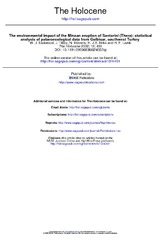The environmental impact of the Minoan eruption of Santorini (Thera): statistical analysis of palaeoecological data from Golbisar, southwest Turkey
Peer reviewed, Journal article
Permanent lenke
https://hdl.handle.net/1956/2497Utgivelsesdato
2002Metadata
Vis full innførselSamlinger
Originalversjon
https://doi.org/10.1191/0959683602hl557rpSammendrag
A tephra layer originating from the mid-second millennium BC (3300 14C yr BP) ‘Minoan’ eruption of Santorini (or Thera) in the Aegean has been found in lake sediments at G6lhisar in southwest Turkey. Microstratigraphic analyses of tephra shard concentration (TSC), pollen, diatoms, sponge spicules and nonsiliceous microfossils in sediments from Gtlhisar permit the impact of this major volcanic eruption on terrestrial and aquatic biota to be investigated quantitatively. Partial redundancy analysis and associated Monte Carlo permutation tests suggest that TSC alone cannot be shown to have had a demonstrable independent and statistically significant effect on terrestrial pollen, non-siliceous microfossil or diatom assemblages. The lack of any clear, discernible change in the terrestrial pollen composition following tephra deposition suggests that there was minimal impact on regional vegetation over decadal-to-century timescales. However, evidence that the deposition of Santorini tephra may have had an impact on the lake system comes from the combined effect of lithology and TSC (which significantly covary) that explains a significant amount of variance in the aquatic data sets. In particular, diatoms and non-siliceous algae show increases in concentration following tephra deposition, exhibiting what appear to be decadal response times to perturbation. These imply enhanced lake productivity due to accelerated input of silica and other nutrients following tephra dissolution.
